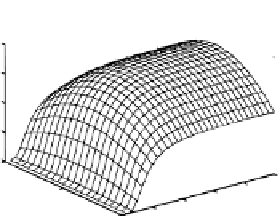Biomedical Engineering Reference
In-Depth Information
Fig. 4.8
Left
: isometric active stress development for different muscle stretches
λ
activated
by a certain intracellular calcium transient using the filament overlap model of Murtada et al.
(
2012
); related material parameters are
μ
a
=
5
.
3MPa,
α
=
26
.
7kPa,
β
=
β
1
=
0
.
0083 s
−
1
and
κ
AMp
=
204 kPa.
Right
: isotonic shortening and extension velocities for different after-loads (Mur-
tada et al.,
2012
). Compare with the shortening velocity presented in Fig.
4.2
D
Through the updated evolution law based on Hill's equation (
4.22
), the model
was able to simulate a (very) realistic nonlinear behavior of the isotonic force-
velocity relationship seen in smooth muscle. With the extended evolution law (
4.23
)
a realistic behavior of the force development during sudden muscle extension and
also the extension velocity were obtained. One of the advantages with the mathe-
matical form of the extended filament sliding evolution law is the convenience of
reducing it to its original form (
4.22
) when only simulating sudden muscle shorten-
ing.
4.4 Discussion and Concluding Remarks
In the present chapter, a review of a mathematical approach for studying smooth
muscle contraction and relaxation was presented. There are several different smooth
muscle models available in the literature and they have some characteristics in com-
mon, however the reviewed approach (Murtada et al.
2010a
,
2010b
,
2012
) is one
of the few which is able to simulate a realistic mechanochemical behavior of iso-
metric contraction and relaxation at different muscle stretches and isotonic shorten-
ing/extension through one single model. The described approach models the active
tension development by considering the number of attached cross-bridges, the aver-
age elastic elongation of attached cross-bridges and the filament sliding theory.
With the implemented filament overlap function, the model is able to simulate
the well-known length-tension behavior which is very relevant for smooth muscle
organs functioning at a large range of deformations. The model couples intracel-
lular calcium
Ca
2
+
]
with muscle contraction and relaxation through the Hai and
Murphy myosin kinetics model (Hai and Murphy,
1988
) and the smooth muscle
model of Murtada et al. (
2012
). The myosin kinetics model describes the myosin
[
















































































































































































































































































































































































































































































































































































































































































































































































































































































































